
Sassafras is a genus of three extant and one extinct species of deciduous trees in the family Lauraceae, native to eastern North America and eastern Asia. The genus is distinguished by its aromatic properties, which have made the tree useful to humans.
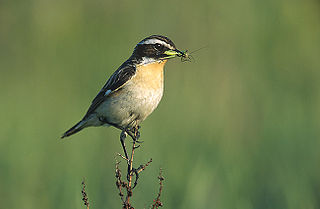
Chats are a group of small Old World insectivorous birds formerly classified as members of the thrush family (Turdidae), but following genetic DNA analysis, are now considered to belong to the Old World flycatcher family (Muscicapidae).

The northern wheatear or wheatear is a small passerine bird that was formerly classed as a member of the thrush family Turdidae, but is now more generally considered to be an Old World flycatcher, Muscicapidae. It is the most widespread member of the wheatear genus Oenanthe in Europe and North and Central Asia.
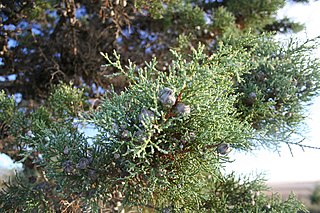
Cypress is a common name for various coniferous trees or shrubs of northern temperate regions that belong to the family Cupressaceae. The word cypress is derived from Old French cipres, which was imported from Latin cypressus, the latinisation of the Greek κυπάρισσος (kyparissos).

Oenanthe, known as water dropworts, oenanthes, water parsleys, and water celerys, are a genus of plants in the family Apiaceae. Most of the species grow in damp ground, such as in marshes or in water.

Vallisneria is a genus of freshwater aquatic plant, commonly called eelgrass, tape grass or vallis. The genus is widely distributed in tropical and subtropical regions of Asia, Africa, Europe, and North America.

Vallisneria americana, commonly called wild celery, water-celery, tape grass, or eelgrass, is a plant in the family Hydrocharitaceae, the "tape-grasses". V. americana is a fresh water species that can tolerate salt, living in salinities varying from fresh water to 18 parts per thousand, although the limit to the salt tolerance is unclear, and is generally dependent on the duration and intensity of the plants’ exposure to the saline water. V. americana is a deep rooted plant with leaves, approximately one inch wide, with the ability to rise two or more meters above the clustered base of the plant. Contrary to the implications of one of its common names, wild celery bears little to no resemblance to the celery used as a vegetable. V. americana grows under water and is consumed by various animals, including the canvasback. The plants themselves are long, limp, flat, and have a green mid-ridge.

Oenanthotoxin is a toxin extracted from hemlock water dropwort and other plants of the genus Oenanthe. It is a central nervous system poison, and acts as a noncompetitive antagonist of the neurotransmitter gamma-aminobutyric acid. A case has been made for the presence of this toxin in local Oenanthe species playing a causative role in euthanasia in ancient Sardinia. It was crystallized in 1949 by Clarke and co-workers. It is structurally closely related to the toxins cicutoxin and carotatoxin. Oenanthotoxin is a C17 polyacetylene isomer of cicutoxin.

A freshwater aquarium is a receptacle that holds one or more freshwater aquatic organisms for decorative, pet-keeping, or research purposes. Modern aquariums are most often made from transparent glass or acrylic glass. Typical inhabitants include fish, plants, amphibians, and invertebrates, such as snails and crustaceans.
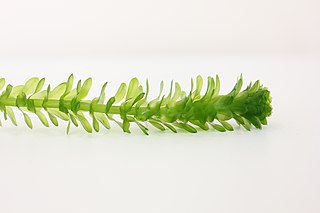
Egeria densa, the large-flowered waterweed or Brazilian waterweed, is a species of Egeria native to warm temperate South America in southeastern Brazil, Argentina, and Uruguay. It is considered a problematic invasive species due to its use in home aquariums and subsequent release into non-native habitats.
Wild celery is a common name for several plants. It can refer to:

Oenanthe pimpinelloides is a species of flowering plant in the family Apiaceae known by the common name corky-fruited water-dropwort.
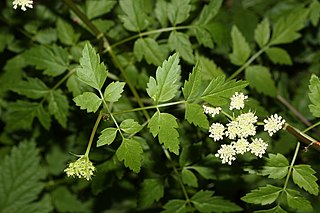
Oenanthe sarmentosa is a species of flowering plant in the family Apiaceae known by the common name water parsley. It is native to western North America from Alaska to California, where it grows in wet areas, such as streambanks. It is sometimes aquatic, growing in the water. The plant has been used in cultivation in wetlands, and the recent discovery of several colonies growing by a stream in Illinois demonstrates its capacity to become a noxious weed if it is introduced elsewhere. This is a perennial herb growing to a maximum height near 1.5 meters. The leaves have blades up to 30 centimeters long borne on petioles up to 35 centimeters in length. The parsley-like leaf blade is divided into serrated, lobed leaflets. The inflorescence is a compound umbel of many flowers with bright white to red-tinged petals.
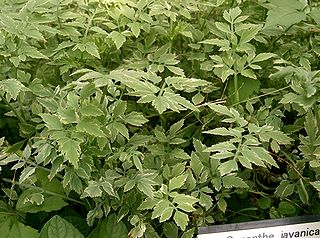
Oenanthe javanica, commonly Java waterdropwort, Chinese celery, Indian pennywort, Japanese parsley, water celery, water dropwort and minari, is a plant of the water dropwort genus originating from East Asia.. It has a widespread native distribution in temperate Asia and tropical Asia, and is also native to Queensland, Australia.

Depressaria daucella is a moth of the family Depressariidae. It is found in most of Europe, except most of the Balkan Peninsula. It is also found in North America.
Water parsley is a common name for several species of plants and may refer to:
Dropwort is a common name for several plants and may refer to:
Parapoynx obscuralis, the obscure pondweed moth, American china-mark or vallisneria leafcutter, is a moth in the family Crambidae. It was described by Augustus Radcliffe Grote in 1881. It is found in North America, where it has been recorded from Nova Scotia to Florida, west to Texas and north to Wisconsin and Ontario. It is also found in Great Britain, where it is naturalised in aquatic nurseries through accidental introduction.
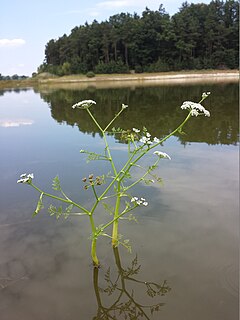
Oenanthe aquatica, known in English as fineleaf water dropwort, fine-leaved water dropwort, fine leaved water dropwort, fineleaf water-dropwort, fine-leaved water-dropwort or fine leaved water-dropwort is an aquatic flowering plant in the family Apiaceae.














